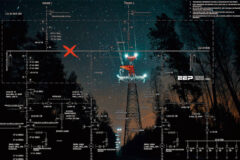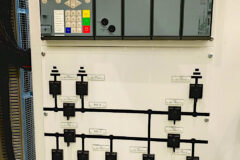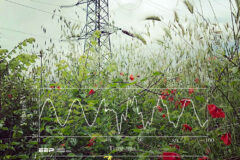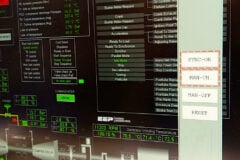
Continued from part two – Capacitor Banks In Power System (part two)
Maximum Permissible Current
Capacitor units shall be suitable for continuous operation at an RMS current of 1.30 times the current that occurs at rated sinusoidal voltage and rated frequency, excluding transients. Taking into account the capacitance tolerances of 1.1 CN, the maximum permissible current can be up to 143 IN.
These overcurrent factors are intended to take care of the combined effects of harmonics and overvoltage’s up to and including1.10 UN, according to IS 13340.
Discharge Device
Each capacitor unit or bank shall be provided with a directly connected discharge device. The discharge device shall reduce the residual voltage from the crest value of the rated value UN to 50 V or less within 1 min, after the capacitor is disconnected from the source of supply. There must be no switch, fuse or any other isolating device between the capacitor unit and the discharge device.
A discharge device is not a substitute for short-circuiting the capacitor terminals together and to earth before handling.

Where:
t = time for discharge from UN Jr to UR(s),
R = equals discharge resistance
C = rated capacitance (pF) per phase,
UN = rated voltage of unit (V),
UR = permissible residual voltage
k = coefficient depending on both resistance and capacitor unit connections, Value of k to be taken as per IS13340
Configuration of Capacitor bank
A delta-connected bank of capacitors is usually applied to voltage classes of 2400 volts or less.
In a three-phase system, to supply the same reactive power, the star connection requires a capacitor with a capacitance three times higher than the delta connected capacitor. In addition, the capacitor with the star connection results to be subjected to a voltage √3 lower and flows through by a current √3 higher than a capacitor inserted and delta connected.
For Three Phase STAR Connection
Capacity of the capacitor bank C = Qc / (2πFrUr2)
Rated current of the components IRC = 2πFrCUr / √3
Line current I = IRC
Three Phase Delta Connection
Capacity of the capacitor bank C = Qc / (2πFrUr2.3)
Rated current of the components IRC = 2πFrCUr
Line current I = IRC / √3
Where,
Ur = rated voltage, which the capacitor must withstand indefinitely;
Fr = rated frequeny
Qc = generally expressed in kVAR (reactive power of the capacitor bank)
While deciding the size of capacitor bank on any bus it is necessary to check the voltage rise due to installation of capacitors under full load and light load conditions. It is recommended to limit the voltage rise to maximum of 3% of the bus voltage under light load conditions. The voltage rise due to capacitor installation may be worked out by the following expression.
Voltage Drop/Rise Due to Switching
Switching on or off a large block of load causes voltage change. The approximate value can be estimated by:
Voltage change ≅ load in MVA/fault level in MVA
Switching a capacitor bank causes voltage change, which can be estimated by:
Voltage change ≅ capacitor bank rating in MVA /system fault level in MVA
![]()
Where,
% VC = % voltage change or rise due to capacitor
% X = % Reactance of equipment e.g. Transformer
If the capacitor bank is STAR connected than the required value of C will be higher in comparison to the value of C in DELTA connection for the same value of required kVAR. Higher value of C will cause higher voltage rise of the system causing nuisance tripping of the equipment provided with over voltage protection.
It is common practice to leave the star-connected capacitor banks ungrounded (there are separate reason for leaving it ungrounded) when used in the system or use delta-connected banks to prevent the flow of third harmonic currents into the power system through the grounded neutral.
Large capacitor banks can be connected in STAR ungrounded, STAR grounded or delta. However, the wye ungrounded connection is preferable from a protection standpoint. For the STAR ungrounded system of connecting single capacitor units in parallel across phase-to-neutral voltage the fault current through any incomer fuse or breaker of capacitor bank is limited by the capacitors in the two healthy phases. In addition the ground path for harmonic currents is not present for the ungrounded bank.
For STAR grounded or delta-connected banks, however, the fault current can reach the full short circuit value from the system because the sound phases cannot limit the current.
Detuning of Capacitor Banks
In an industrial plant containing power factor correction capacitors, harmonics distortions can be magnified due to the interaction between the capacitors and the service transformer. This is referred to as harmonic resonance or parallel resonance. It is important to note that capacitors themselves are not main cause of harmonics, but only aggravate potential harmonic problems. Often, harmonic-related problems do not show up until capacitors are applied for power factor correction.
Impedance of the capacitor decreases with increase in frequency. Capacitor capacity to cancel out harmonic decreases with increase in frequency. This offer the low impedance path to harmonic currents. These harmonic currents added to the fundamental current of capacitors can produce dangerous current overloads on capacitor. Each of the harmonic currents causes the voltage drop across the capacitor. This voltage drop is added to the fundamental voltage. Thus in presence of harmonics higher voltage rating of capacitor is recommended. This overvoltage can be much above permissible 10% value when resonance is present.
Another important aspect is resonance which can occur when p.f. capacitors forms the series or parallel resonant circuit with impedance of supply transformer. If the resonance frequency of this LC circuit coincides with one of the harmonic present, the amplitude of the harmonic current flowing through LC circuit is multiplied several times damaging the capacitors, supply transformer and other network components.
Precautions to be taken while switching ON a capacitor bank
Make sure that there is adequate load on the system. The normal current of the capacitor to be switched ON at 440 volts is say 100 amps. Therefore the minimum load current at which the capacitor should be switched ON is 130-150 amps.
If one capacitor unit is already on and a second one is to be added then minimum load current on this bus system must be equal to or more than the combined capacitor current of the two banks by at least a factor of 1.35 to 1.5.
After switching off the capacitor – wait for at least one minute before switching it on. Earth all the live terminals only after waiting for one minute before touching these with spanner etc. If above precautions are not observed, this could lead to dangerous situations both for plant and personnel.
Switch off the capacitors when there is not enough load. This is a MUST. If the capacitors are kept ON when there is no load or less load then Power factor goes to leading side and system voltage increases which may cause damage to the capacitors as well as other electrical equipments and severe disturbance can be caused.)
If the line voltages are more than the capacitor rated voltage, then do not switch on the capacitors. As the load builds up, the line voltage will fall. Switch on the capacitors then only.
Operation of capacitor bank and co relatation with harmonics in the system
Harmonics can be reduced by limiting the non-linear load to 30% of the maximum transformer’s capacity. By doing this we ensure that power system does not exceeds the 5% voltage distortion level of IEEE Standard 519. However, with power factor correction capacitors installed, resonating conditions can occur that could potentially limit the percentage of non-linear loads to 15% of the transformer’s capacity.
FR = √kVASC / kVARC
Where,
FR = resonant frequency as a multiple of the fundamental frequency
kVASC= short circuit current at the point of study
kVARC = capacitor rating at the system voltage
If FR equals or is closed to a characteristic harmonic, such as the 5th or 7th, there is a possibility that a resonant condition could occur. Almost all harmonic distortion problems occur when the parallel resonance frequency is close to the fifth or seventh harmonic, since these are the most powerful harmonic current components. The eleventh and thirteenth harmonics may also be worth evaluating.
True and displacement power factor specially with regards to variable speed drives?
Power factor of variable speed drives – With the six-step and current source inverters, the power factor will be determined by the type of front end used. When SCR’s are used, the power factor will be relatively poor at reduced speeds. When diodes with a dc chopper are used, the power factor will be the same as a PWM inverter, which is relatively high (near to unity) at all, speeds.
True power factor is the ratio of real power used in kilo watts (kW) divided by the total kilo volt-amperes. Displacement power factor is a measure of the phase displacement between the voltage and current at the fundamental frequency. True power factor includes the effects of harmonics in the voltage and current. Displacement power factor can be corrected with capacitor banks. Variable speed drives have different displacement power factor characteristics, depending on the type of rectifier.
PWM type variable speed drives use a diode bridge rectifier and, have displacement power factors very close to unity. However, the input current harmonic distortion can be very high for these variable speed drives, resulting in a low true power factor. True power factor is approximately 60% despite the fact that the displacement power factor is very close to unity. The true power factor can be improved substantially in this case through the application of input chokes or transformers which reduce current distortion.
Capacitor banks provide no power factor improvement for this type of variable speed drives and can make the power factor worse by magnifying the harmonic levels.











I have a capacitor Bank of 48MVAR installed on 132kv Bus bar. Please let me know how to test its capacity testing in Mvar before energixation on system??
Introduction – A retired Service Personnel of Siemens , My Main object of searching – to observe the effect – of applying higher voltage- compared to the – rated voltage on a CAPACITOR BANK of 300 KVAR, Rated Voltage – 440V AC & to Calculate the rise of voltage Effectively.
In Fact It has given so many things but not the needed one.
Normally such problems are minor , but effect of covid -19 & lock down throughout India
The Input(H.T) From SEB increases considerably affect the L.T side & Cap BANK. When the Capacitors are sw ON additional voltage rise takes place . No solution for this is observed. For Info In rural Area this is a common problem & during Lock down it is sevear – Needs Support
I am Thinking a Lot But My Problem Is stated above , do you feel to resolve the issue,
I would suggest please read once more & reply back if you are willing .
regards R.Roy
PLEASE MY CAPACITOR BANK IS JUST BLOWING THE PROTECTIVE 4AMP. FUSE OF REACTIVE POWER CONTROL RELAY PLEASE I WILL LIKE TO KNOW THE CUASE AND REMEDY. THANK YOU.
helo
please quote
cif manila, philippines
5 pcs. capacitor for series reactor 505v, 100VAR, 3PHASE
Thanks for the interesting knowledge
respected sir ! im pleased to see details of capacitor banks . my question is that what is the minimum wattage to install a capacitor bank . i have 493kw chiller wether this load need a seperate capacitor bank or not.
i will be really thankful to you.
regards
How does a automatic discharge resistor in 11kV Double Star Connected Capacitor bank works ?
Does voltage drop across this resistor occurs only when supply is disconnected or also when the 11kV supply is ON.
i would like to know that, what is the net effect of ; if a LV capacitor bank power supply feed through mid point of PCC & End of PCC feeder??
Hi….I want to know what happens when I put two series capacitors as a integrator capacitor in an op-amp integrator that one of these capacitors will be reset by a switch at aparticular time?
How is the output waveform?
thanks
Can any one help me to solve a problem using a capacitor (10uF, 400V) used 2years, before 1 month it was working GOOD but now a days,
I find a peculiar problem at this time using this capacitor.
Supply voltage = 220v , Load current = 1.2A, P.F = 90% without Connecting Capacitor,
but when i connect it, supply voltage increases near about 223v, supply current = 1.5A, P.F= 77%
How is it possible? i cant understand.
what is the reason of this phenomenon?
Old Capacitor would convert to an Inductor? (Funny)
Is it O.K if we ground capacitor terminals via discharge contactor and grounding resistors for fast discharging of capacitors.
Good day
I want to know how to derive the Voltage change or rise due to capacitor – formula
Voltage change ≅ capacitor bank rating in MVA /system fault level in MVA
please refer me to any source were I could find the derivation
Thank you
Dear sir,
I want to know that, how we ll check the condition of capacitor bank in field.
*** : Actually we installed a capacitor bank (114 kvar in parallel with 500HP motor & Supply voltage is 3.3 KV ) and I had done a maintenance to it, while doing I have found two HT protection fuses are damaged because of this I had a doubt on capacitor bank also. so I had measured capacitor bank values Ph to Ph and Ph to ground but by these measured values, how can I come to know that Cap.bank is in good condition..
please guide me sir
Thanku in advance
what is rating of your HT protection fuse?
When plant load is sufficient then p.f is 0.88 but at no load or less load condition p.f decrease to 0.8 or more less why plz help… our plant is ice plant and 415 volt system
is there any induction motor or not in your plant if yes then this is happen due to motor as we know that no load pf of induction motor is very low.
How can I connect 5×40 kvar capacitor for powerfactor correction ,parallel or series…with explanations
in part two you mentioned that a factor of 1.5 must be multiplied considering the overloading of the capacitor, but here you mentioned 1.3. i am confused, could you help me out here please.